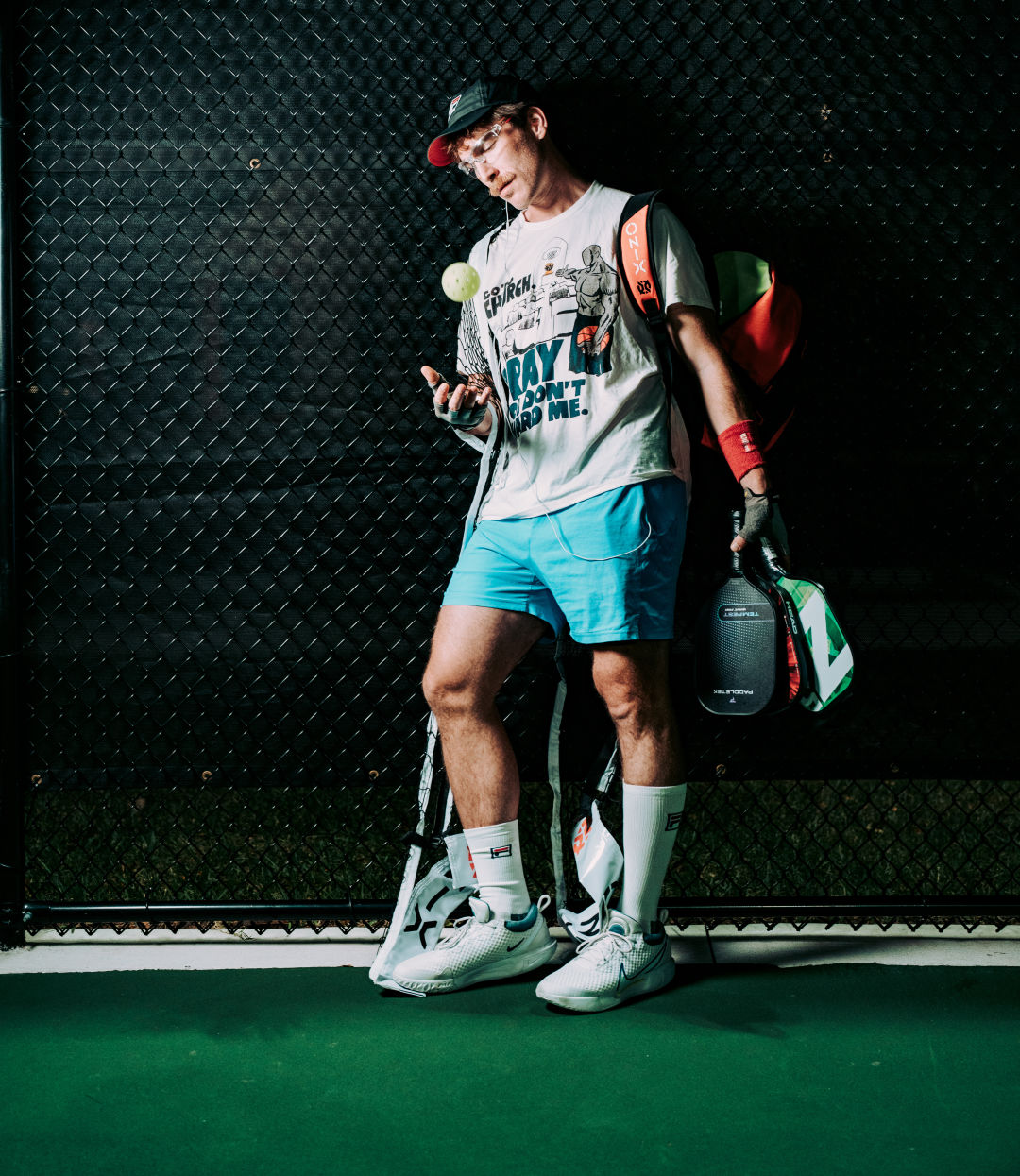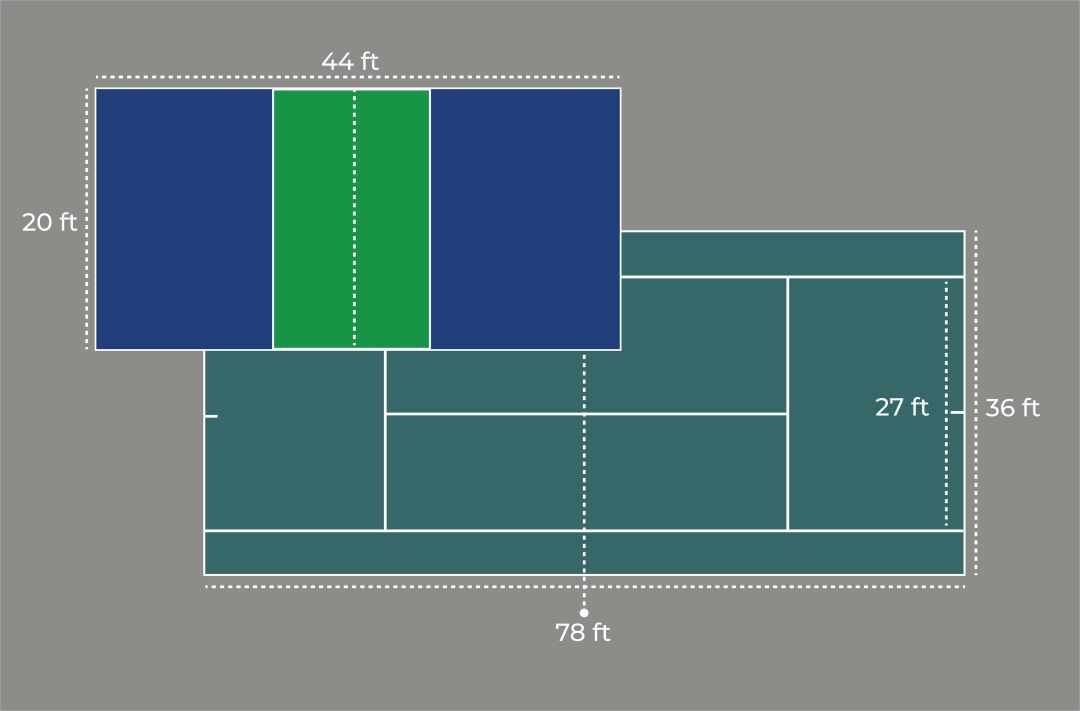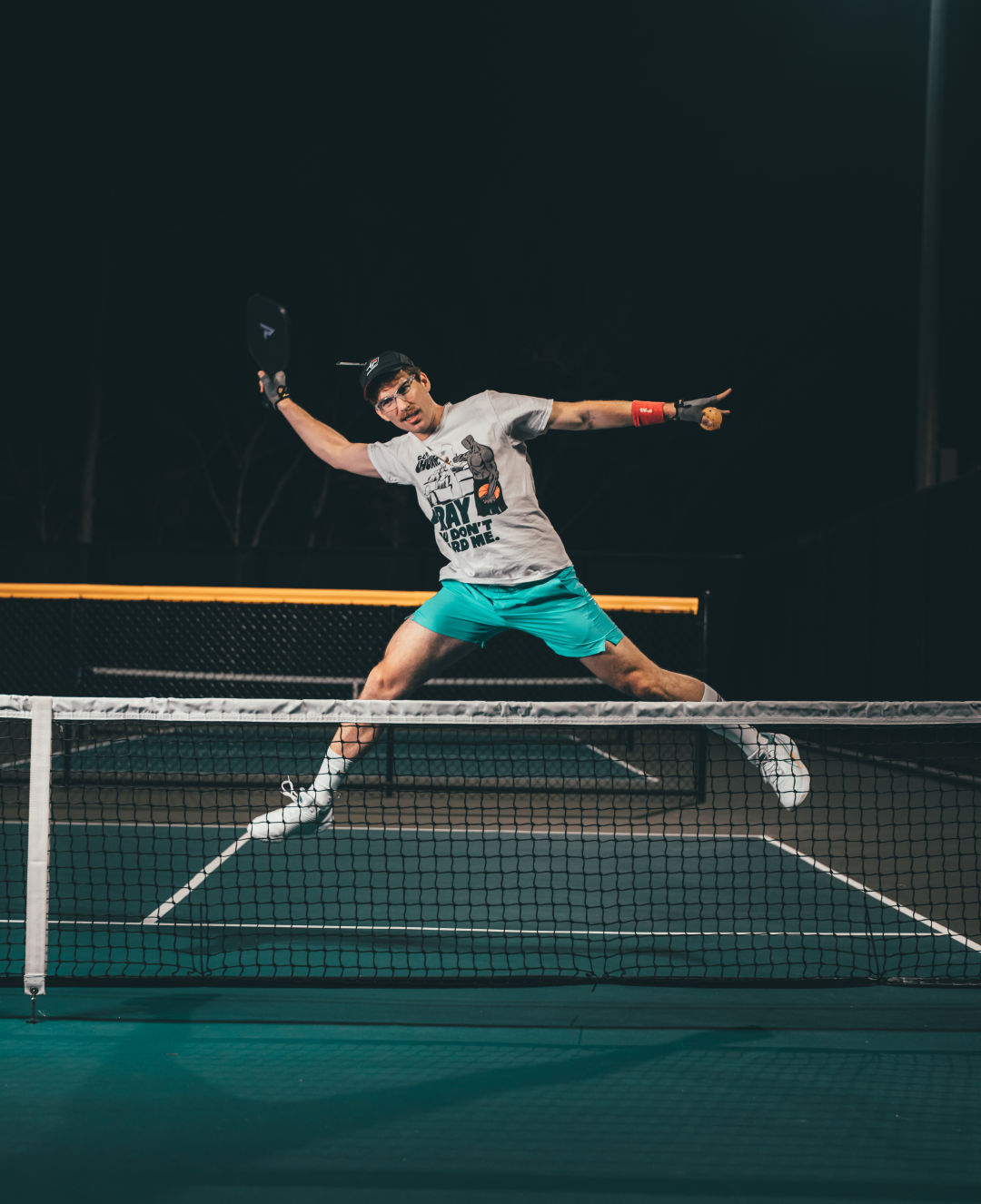
Can a Millennial Love Pickleball?
It's nearly 10 o'clock at night and just off the newly extended Legacy Trail it sounds like I’m deep in the Everglades in the middle of a frog-mating frenzy. But the intermittent pops filling the night air are not the sounds of animals—they are the sounds of scores of pickleball players rallying. There are 12 courts at the Pompano Trailhead near Tuttle Avenue, and they are almost entirely filled with people playing pickleball well into the night.
I’m surprised so many players are still going at it this late on a weeknight, but maybe I shouldn’t be. Because, for the past year, pickleball has been inescapable.
Celebrities like the Kardashians are endorsing the sport, venture capitalists are pouring millions of dollars into leagues and facilities and equipment and even former top tennis players are trading in their racquets for paddles. Every week, it seems like there is another article in a legacy publication about its rising popularity. The New York Times fawned over how good the sport is for your heart, while The New Yorker claimed the game could heal a divided America.
It’s not all hype. Pickleball grew nearly 40 percent between 2019 and 2021, making it the fastest growing sport in America, and nearly 5 million people now play the game. Sarasota County just built the Pompano courts last year and Manatee County just opened another 20 courts at G.T. Bray Recreation Center. Theories abound about how the game suddenly became so prominent. Fans point to how easy it is to play, older folks say it’s gentle on the joints and a fun way to stay in shape, and a lot of signs point to the Covid-19 pandemic and how pickleball
provided a seemingly safe way for people to get out of the house and interact
with others.
But the game is not new. Pickleball was first created in 1965 in Bainbridge, Washington, by some dads who wanted to play with their kids. Why did it take nearly 60 years for the sport to blow up? Is it here to stay? Or is it just another
passing fad? And can the sport appeal to a younger demographic, or will it belong
in the realm of retirees?

Can pickleball appeal to a younger demographic, or will it belong in the realm of retirees?
Image: Everett Dennison
First, I had to learn the game. I took a lesson with Cathy Denault, a certified instructor with the International Pickleball Teaching Professional Assocation, who has been playing for more than seven years. Denault is in her 50s and hails from Canada. She’s lithe and very tan. She gave me the rundown of the game’s basic rules.
Games go to 11 and you must win by two points. Play begins with an underhand serve from the baseline, but most players rarely stay near the baseline. After a couple of hits, they run up to the kitchen—a box just in front of the net
that you must stay outside of unless the ball lands in the box first. That’s when
the dinking begins. A dink is a gentle lob over the net, and sometimes dink rallies
can last 50 shots. Eventually, someone whacks the ball and tries to score.
Denault taught me how to serve, return and dink. When it came time to play a few games, she won every time and she took great pleasure in beating me. I became increasingly frustrated. I just couldn’t figure out the subtleties of the game. I figured my youth and tennis experience would translate better than they did. Denault was gracious in victory.
Jeff Lewis has owned and operated Total Tennis for more than 50 years. About
five years ago, he started carrying a handful of pickleball paddles and only kept them on display for about half the year. “Something happened about half a year ago,” Lewis says. “People started coming in in droves. And it’s really exploding here in Sarasota.”
Lewis believes the allure is that it’s easy, cheap and social. “The nice thing about pickleball is if you’re not real athletic, you can pick it up quickly,” he says. “If you’re a good tennis player, you are a god on the pickleball court. It’s so much
easier to play.”
While Lewis still prefers tennis, he plays pickleball with his mother because her tennis days are over. “I’m not going to give up tennis, but I don’t have a problem with pickleball,” Lewis says. “It’s fun.” He says he’d be a fool not to embrace the sport. If he did, he’d just be turning money away. “We have that older clientele and people from the Midwest come down here and they play it the most,” he says. “As long as my customer is happy, I don’t care. They’re getting out and playing and enjoying themselves.”
But not everybody is all that happy with the ascent of pickleball. Jean Kirshenbaum, a lifelong tennis player, thinks it’s a scourge. “I have a lot of negative feelings about it,” Kirshenbaum says. She first noticed the sport a few years ago when they painted pickleball lines on the tennis courts at Twin Lakes Park. “All of a sudden, these blue lines appeared,” she says. “It was distracting to
a lot of us players. The pickleball players have very poor court etiquette. The balls would roll over into our court. And it’s very noisy.”
Kirshenbaum isn’t alone in her irritation. Pickleball courts throughout the country are getting shut down by local neighborhood associations for their
clamor.
The other thing that irks Kirshenbaum is that the game requires less skill than tennis. “It’s just giant ping-pong,” she says. “It doesn’t have the grace of tennis.”
I’m inclined to agree with her. Yes, it’s true that pickleball has a low barrier of entry, and so it’s accessible to more people. Tennis, meanwhile, takes a lifetime to
master. I tried watching some professional pickleball matches and found them boring, and it seems like others agree. A match between two of the best pickleball players in the world garnered just 25,000 views in over three months on YouTube.
“This is one of the best singles matches I’ve ever seen,” one commenter wrote. Nevertheless, I doubt there will ever be a Roger Federer of pickleball.
Kirshenbaum attended a couple of meetings with Sarasota County officials to protest the county’s growing support of pickleball. “I was upset because they didn’t even bother to do a study of the data and determine whether pickleball was popular enough,” she says. “One county commissioner just read an article about how popular it was and that was enough to convince her.”
Sarasota County Parks, Recreation and Natural Resources director Nicole Rissler says the county is working diligently to add more pickleball courts. “We’re planning additional dedicated pickleball courts, including six at Potter Park, six at Nokomis Park, three at Bypass Park, four at the Englewood Sports Complex, four at Fruitville Park, six at Twin Lakes Park and four at the Youth Athletic Complex,” Rissler wrote in an email statement. It appears that Kirshenbaum is fighting a losing battle.
One group that really seems to love pickleball is orthopedic surgeons. “It’s been very good for business,” says Dr. Patrick O’Neill, a foot and ankle surgeon over at Kennedy-White Orthopaedic Center. “I’ve seen a lot of us middle-aged guys who haven’t been playing much sports in a while go out to the pickleball courts and break an ankle or rupture an Achilles.” Because there’s a lot of starting and stopping in pickleball, all those people out there who decide to pick up the sport without consistently training their bodies may end up going under the knife. And it’s mostly affecting men. “For every one woman I see, I see a hundred guys,” O’Neill says.
Besides the uptick in business, O’Neill says he’s happy to see people playing and becoming passionate about a sport. “I had one 80-year-old guy come in. He had already ruptured one of his Achilles playing pickleball, and he just ruptured the other,” O’Neill says. “He said, ‘Doc, I need to get back out there.’ I fixed him up and he was good to go.”

A graphic showing the size of a typical tennis court when compared to a smaller pickleball court.
Image: Staff
There's a ton of money going into pickleball. What could have been a humble leisure sport is now a resource to be mined, and rival associations are forming to snag a piece of the growing pie. There are two pickleball halls of fame, even though there isn’t anyone famous enough to be in one, and there are two governing bodies fighting each other for pickleball supremacy: the Federation of Pickleball and the newly formed World Pickleball Federation. There are also two domestic pro tours jockeying for pickle power: the Association of Pickleball Professionals and the Professional Pickleball Association. There are also now more than 300 companies making pickleball paddles.
The last time I remember something getting this kind of unadulterated praise and investment was during the Bitcoin and NFT craze, and that didn’t end so well. The sport has even attracted a lot of the same people who were cheerleaders for crypto—people like Gary Vee, a self-help finance bro who recently joined an ownership group that bought a Major League Pickleball expansion team ahead of the 2023 season. Or people like Tom Brady, who is being sued for endorsing FTX, the shady cryptocurrency exchange that went bankrupt. There was even a pickleball tournament a couple years ago that offered crypto as a cash prize.
“I would not be doing this if it was just a flash in the pan,” says Brian McCarthy, a commercial real estate and business entrepreneur who, along with his wife Valerie and his business partner Matthew Gordon, plan on spending $180 million dollars to build at least 15 private indoor pickleball clubs in Florida. That includes The Pickleball Club, a 12-court facility in Lakewood Ranch, which held its grand opening on May 2.
McCarthy believes Florida is pickleball’s adopted homeland. “It didn’t start here, but we’ve got big tournaments down in Naples and that’s bringing more attention. The largest number of courts in the country are in The Villages. There are at least 240 courts now, and we are building another one up there, too. Plus, the state is growing like gangbusters and me and Ron [DeSantis] are like this,” McCarthy says as he raises his hand and crosses his index and middle fingers.
McCarthy believes pickleball has a lot of room to grow. Besides its ease of entry, it’s a game the whole family can play together. “It started out as a family activity when it was founded back in the state of Washington, and it’s still true today,” he says. “It’s the most intergenerational sport that I’m aware of. Parents can play with their kids, grandparents can play with their grandkids. It’s really amazing. Other than checkers I can’t come up with anything else where you can do that.”
The sport is most popular among older folks, with half of all “serious” pickleball players being over the age of 55, according to USA Pickleball, but the fastest-growing segment of pickleball players is people under 24. McCarthy’s pickleball club is private, but he believes that it is affordable. “We priced it so that everybody could afford to join,” he says.
I asked him how much it costs. “You’re a millennial, right? You probably can’t afford a house, but you could afford a $1,000 initiation fee and then $100 a month after that,” he says. “We can’t do it for free. We spent $12 million building this thing.”
To reach younger people, McCarthy says he’s taking a page from Steve Jobs’ time at Apple. “We are targeting kids by giving schools free pickleball equipment,” he says. “That’s how Apple got started, putting their computers in the schools. If you get the kids hooked early, they’ll be hooked forever.”
The Pickleball Club is providing free paddles, balls and nets to private schools and after-school agencies like the Boys & Girls Clubs and Girls, Inc. “We are trying to make an impact in the community and there are health issues with all these groups,” McCarthy says. “The youth, they’re all sitting behind their computer and their smart phones all the time. Hard to get them out and active. They like playing pickleball. They’re setting up pickleball clubs in the elementary schools. The kids love it.”

How could I hate a game in which people were outside having fun?
Image: Everett Dennison
Denault, my pickleball instructor, recently invited me to an event hosted by the Sarasota Pickleball Club at the Pompano courts where you can hear the dinks late into the night. There were 100 people playing or waiting to play. I’m used to pick-up basketball, in which you have to fight to get on a court. At Pompano, you put your paddle in a slot to mark your place and you can get on a court in no time.
Even though I was a beginner, everyone was friendly and helpful, even when I broke the occasional rule. While I never broke a sweat, the games were competitive and I begrudgingly had a good time. How could I hate a game in which people were outside having fun? It may not be for me, but it gets people outside playing. I even got used to the incessant, noisy pop of the paddle whacking the ball.